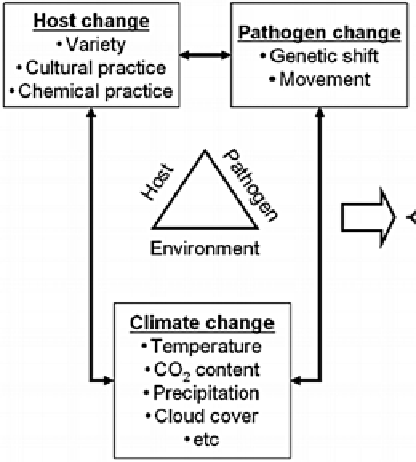Agriculture Reference
In-Depth Information
changed plant architecture and the development
of larger plant organs. Because many foliar
pathogens can take advantage of the more humid
microclimate caused by denser plant growth and
the higher availability of host tissue, pathogen
infection rates of these pathogens usually increase
at higher CO
2
levels. However, the fi nal effect of
increased CO
2
concentrations on the disease
depends on the interaction between the effects on
the pathogen and the effects on the plant under
the specifi c environmental conditions.
Elevated CO
2
may increase C3 plant canopy
size and density, resulting in a greater biomass
with a much higher microclimate relative humid-
ity. This is likely to promote plant diseases such
as rusts, powdery mildews, leaf spots, and blights
(Manning and von Tiedemann
1995
). However,
Kobayashi et al. (
2006
) conclude from literature
reviews that it is not clear whether the disease
severity is enhanced or diminished by a higher
CO
2
level. Research on rice leaf blast and rice
sheath blight in the temperate climates of Japan
showed that elevated CO
2
increased the potential
risks for infection from leaf blast and epidemics
of sheath blight (Kobayashi et al.
2006
).
In soybeans, elevated CO
2
alone or in combi-
nation with ozone (O
3
) signifi cantly reduced
downy mildew (
Peronospora manshurica
) dis-
ease severity by 39-66 % across a 3-year study.
In contrast, elevated CO
2
alone or in combination
with O
3
signifi cantly increased brown spot
(
Septoria glycines
) severity, but the increase was
small in magnitude (Eastburn et al.
2009
).
In wheat, grown at elevated atmospheric CO
2
(700 ppm) and under different fertilization and
water regimes, the host water content, the plant N
content, and the infection rate with powdery
mildew were investigated. In all fertilization
regimes, the mean percent leaf area infected with
mildew was signifi cantly reduced under elevated
atmospheric CO
2
, compared to ambient CO
2
.
In a moderate water supply treatment
(3.6 mm/day), the plants grown in elevated
atmospheric CO
2
concentrations had signifi -
cantly reduced N contents (9.9 %) and signifi -
cantly increased water content (4 %), and the
amount of mildew infection was unchanged. At
higher water supply (5.4 mm/day), host water
Fig. 8.2
Interactions among factors in disease triangle
environment must occur simultaneously. Because
of this intimate relationship among plants, patho-
gens, and the environment, climate change is
expected to affect the incidence and severity of
plant disease. The classic disease triangle recog-
nizes the role of climate in plant diseases as no
virulent pathogen can induce disease on a highly
susceptible host if climatic conditions are not
favorable. Climate infl uences all stages of host and
pathogen life cycles as well as development of dis-
ease. Disease severity over a period can fl uctuate
according to climatic variation.
It is likely that climate change will have posi-
tive, negative, or neutral impacts on specifi c
host-pathogen systems (Coakley et al.
1999
;
Chakraborty et al.
2000b
). In general, climate
change has the potential to modify host physiology
and resistance and to alter stages and rates of
development of the pathogen (Coakley et al.
1999
).
8.3
CO
2
Enrichment
Photosynthesis, leaf area, plant height, total bio-
mass (shoot and root) and crop yield, sugar and
starch content, water-use effi ciency, growth, and
yield are increased in the presence of higher
levels of CO
2
. These effects often result in


Search WWH ::

Custom Search